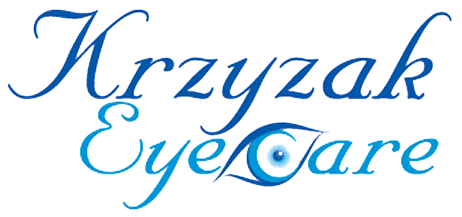Glaucoma
Primary glaucoma is a progressive disease of the optic nerve characterized by specific loss of optic nerve fibers and associated vision loss. It is commonly, but not always associated with increased intraocular pressure.
Detecting Glaucoma
Early stages of glaucoma can fortunately be detected with simple, painless tests. A number of screening tests are performed as part of your annual comprehensive eye examination. Krzyzak Eyecare doctors measure the internal eye pressure or intraocular pressure (IOP) with an instrument called a tonometer.
An evaluation of the optic nerve for signs of glaucoma damage is also performed during the comprehensive eye examination. A variety of methods may be used for this evaluation including the use of the Optomap laser imaging system, which allows for detailed imaging of the retina and optic nerve potentially without the need to dilate your pupil. If your Krzyzak Eyecare doctor feels that there is a risk of having or developing glaucoma further testing may be ordered.
Of greatest concern is the fact that over 50% of optic nerve fibers must be lost to glaucoma before even threshold perimetry shows abnormalities! The very earliest abnormalities in glaucoma show up as changes in the physical appearance and structure of the optic nerve. In the past doctors had to depend on diagrams or photos of the nerve to document its appearance and to detect change over time. This method was very subjective and not very sensitive. Today great advances in optic nerve imaging have been developed. Krzyzak Eyecare has been a leader in performing the newest technologies in optic nerve analysis.
 We utilize the Zeiss Cirrus OCT scanning laser tomography system. This instrument creates a 3-D image of the optic nerve and measures the topography of the nerve and the adjacent nerve fiber layer.
We utilize the Zeiss Cirrus OCT scanning laser tomography system. This instrument creates a 3-D image of the optic nerve and measures the topography of the nerve and the adjacent nerve fiber layer.
OCT (Optical Coherence Tomography) of the nerve fiber layer and the optic nerve head is another advanced diagnostic test available in the diagnosis and treatment of glaucoma at Krzyzak Eyecare. OCT allows us to evaluate the thickness of the nerve fibers surrounding the optic nerve head.
Treating Glaucoma
Until there is a cure for glaucoma, the best weapon against this potentially blinding disease is early detection, leading to a well-planned course of treatment. Predicated on evidence based medicine and contemporary research results, we can now begin preventative treatment in regard to glaucoma.
Treatment for glaucoma may begin if your doctor feels the pressure in the eye is high enough to pose a threat to your optic nerve, or if the risks factors for glaucoma are too great. Typical treatment for glaucoma involves controlling your IOP with drug therapy in the form of prescription eye drops. Modern glaucoma drugs are extremely effective in lowering IOP to acceptable levels. In comparison with therapies used a number of years ago, they are more effective, easier to use (due to less frequent administration per day needed), and have fewer side effects. At Krzyzak Eyecare our goal is to control your glaucoma and prevent vision loss. With the use of the most up to date advances in diagnosis and treatment we are able to achieve this goal consistently.
Some of the most commonly used topical medications for the management of glaucoma include:
- Prostaglandin Drugs: Travatan, Lumigan, and Xalatan
- Beta Blocker Drugs: Timoptic, Betoptic, etc.
- Alpha Adrenergics Drugs: Alphagan-P
- Carbonic Anhydrase Inhibitor Drugs: Trusopt, Azopt
- Combination Agents: Cosopt, Combigan
For the small percentage of patients that do not lower their IOP sufficiently though drug therapy, there are other options. Laser treatment may be tried to open channels for fluid to escape. Laser therapy is relatively painless and is usually performed in the physician’s office in two sessions over the course of a month. Some patients may require additional laser treatments or a third form of treatment, filtration surgery. During this procedure, the physician surgically creates a valve in the wall of the eye using existing eye tissue, allowing the aqueous humor to drain. This therapy, combined with close follow-up, can halt the progression of glaucoma.
Krzyzak Eyecare doctors keep in touch with physicians who are researching the cause and treatment of glaucoma. Some of the exciting research involves developing new techniques to study the outflow channels through which aqueous humor escapes from the eye as well as uncovering new information about the mechanism by which the optic nerve damage occurs.
At Krzyzak Eyecare our goal is to prevent vision loss and provide new therapies and treatments as they become available.
